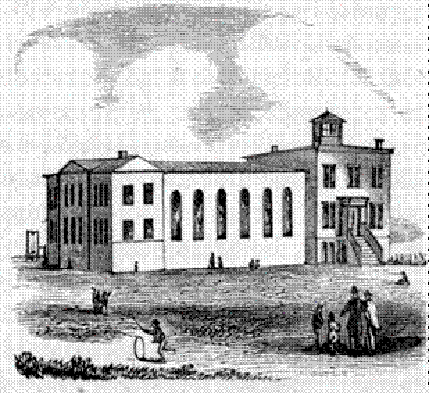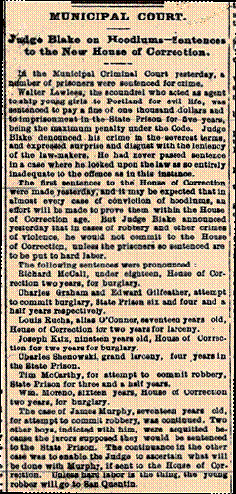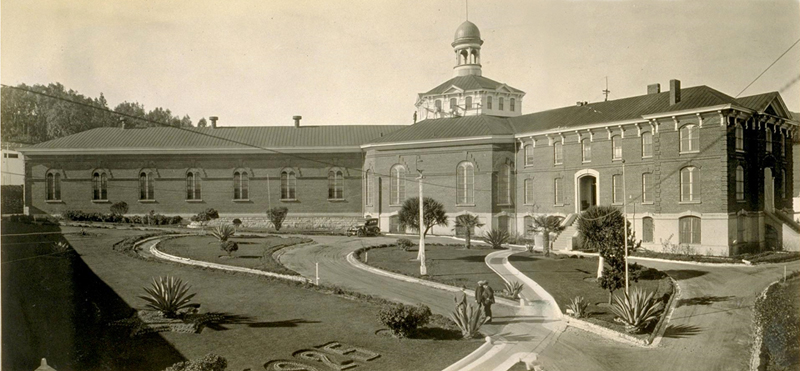
The San Francisco County Ingleside Jail. The location was about 200 feet northwest of the first main railroad line between San Francisco and San Jose. Today that railroad footprint is overlaid by Interstate 280. The original location of the Jail building is completely within the grounds of today's San Francisco City College.
The second significant county jail built in the history of San Francisco ended its lifetime known as the Ingleside Jail, but started out as the "House of Correction" (photo montage: Bancroft Library, UC Berkeley). By the end of its usefulness as a county jail in 1934, the facility had been condemned as a firetrap, disparaged as a political football and had long abandoned its original goal of expecting to rehabilitate its occupants. When it was first opened, however, the facility promised hope and "correction" to those convicted criminals who found themselves incarcerated inside its massive walls.
The Ingleside Jail was located on the property now occupied by San Francisco City College, across from Balboa Park. The term "Ingleside" is a British word meaning "fireplace." Presumably this southwestern neighborhood was just as chilled by the fog back in 1870 as it is today.
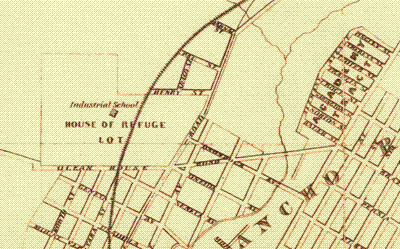
An 1881 map showing the House of Refuge lot with the Industrial School located in the middle of the property.
A 60 foot wide right-of-way through the lot for laying railroad track was sold to the San Jose Railroad in 1865. This was the original railroad mainline between San Francisco and San Jose. This arching right-of-way later became Interstate Highway 280.
Ocean Avenue was originally named Ocean House Road. The portion of the lot east of the railroad right of way became Balboa Park.
The history of the Ingleside Jail started a full two decades before the surrounding San Francisco neighborhood became known as the Ingleside District, only four years after California became a state.
1854 -- In July 1854, the City bought a 100 acre plot of land several miles south of the center of the growing city from land owner John Horner for $15,000. This was designated as "House of Refuge Lot." The intention was to emulate a successful East Coast phenomenon of providing shelter to wayward youth. Nothing was done with the lot until the California State Legislature passed "The Industrial School Act" in 1858, providing for privately run "industrial schools" for wayward youth and minor criminal offenders.
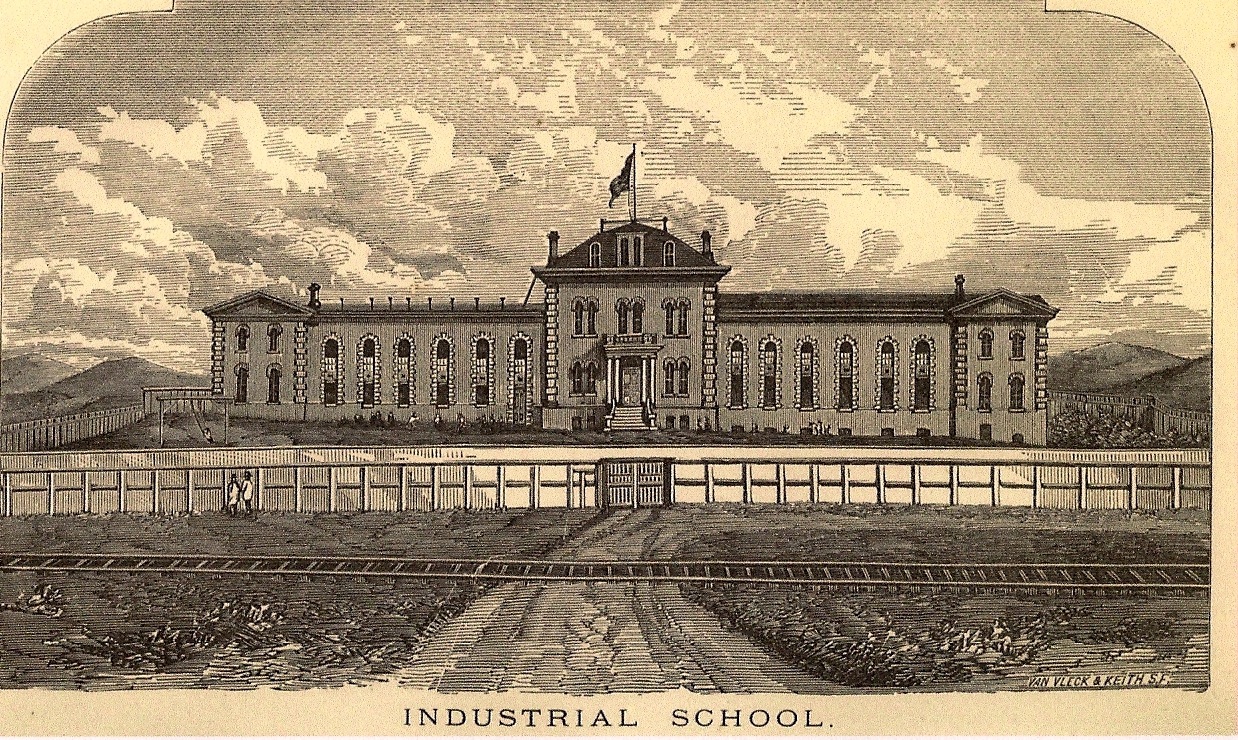
The San Francisco Industrial School. The main railroad line between San Francisco and San Jose ran through the property.
May 17, 1859 -- The Industrial School opened with an elaborate ceremony and "Inauguration Address." In the first year, 60 boys and 5 girls were admitted.
1859 -- A 12-foot fence was erected around the School site.
1865 -- Funding secured for a second wing, which was added in 1865. The addition boosted the School's capacity from 48 to 150 youths.
The School remained co-ed through the 1860's, but there were regular complaints about sexual harassment or misconduct. The Sisters of Mercy were asked to open a separate girls' facility. They opened The Madgalan Asylum on Potrero Avenue near 21st Street and the female inmates of the Industrial School were placed in their care. The Industrial School continued to operate with male inmates until 1892.
1872 -- The Board of the Industrial School passed a resolution to turn over the administration of the School to the City and County of San Francico (Municipal Reports, 1873)
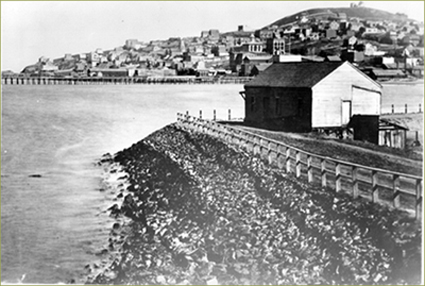
San Francisco's City-County Hospital was located in North Beach from 1864 to 1872. The Toland Medical College was directly next to the Hospital, and benefited from its close proximity.
In 1873, the Sheriff's Department took over the hospital building after it was abandoned by the City. In this photo there are two taller buildings in the upper right, just above the roof of the wooden building in the foreground (see next photo close-up).
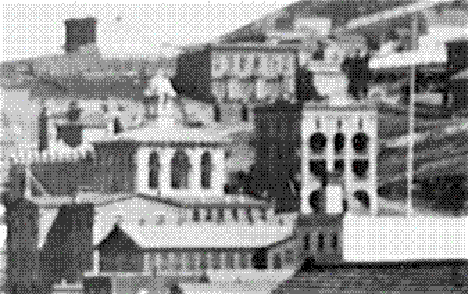
The Toland Medical School building has a copula at the top of the structure; the former City-County Hospital (and new Branch Jail) is directly to the right. The hospital was refitted as a jail and used to ease overcrowding at the Broadway Jail for almost four years. (UCSF LIbrary)
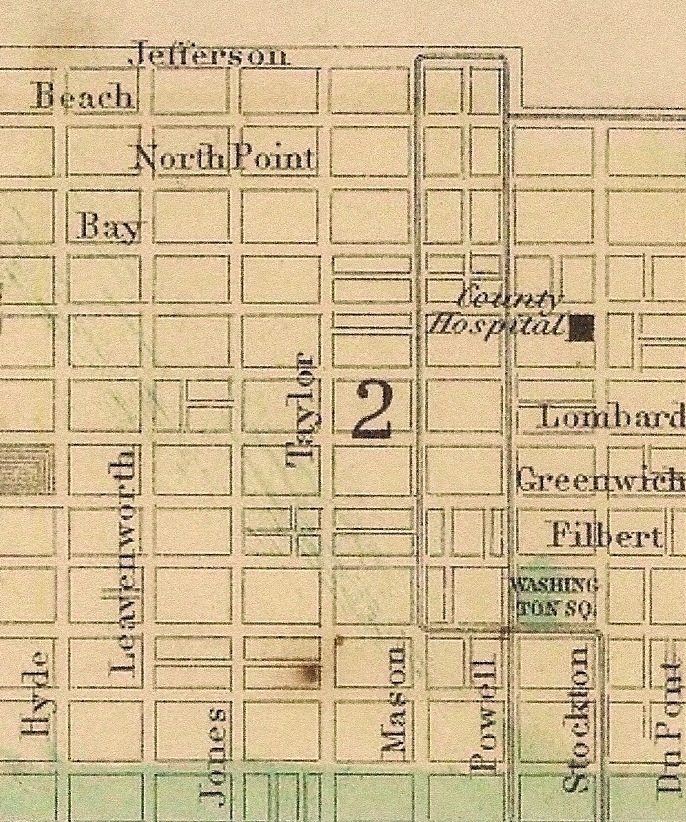
1870 Map Showing County Hospital which later was used as the San Francisco County Branch Jail. (David Rumsey Map Collection)
1874-1876 -- The House of Correction was constructed on the House of Refuge Lot, adjacent to the Industrial School. To pay for the construction, bonds were issued in 1874. The 1876-1877 California State Legislature placed the administration of the House of Correction under the direction of the San Francisco Board of Supervisors. The bonds were to raise $150,000, payable in 20 years at 7% interest.
The House of Correction was authorized by State law and was intended to serve as an intermediary incarceration facility for offenders who were eligible to be sent to State Prison, but who fell into a category of less serious offenders who it was felt could be "reformed." House of Correction prisoners could be required to work while in custody, while county jail prisoners could not.
The building was designed as a central octagonal building with two wings for housing of inmates. The design allowed for 3 more wings to be constructed when expansion was necessary. Eventually a third housing wing was added.
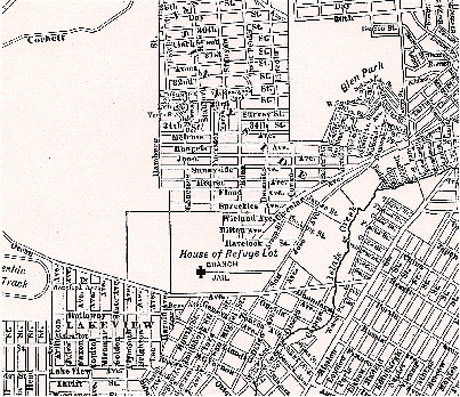
1916 Map of San Francisco showing the "Branch Jail" (the Ingleside Jail). Note the growth of the neighborhoods around the immediate location of the House of Refuge Lot. The issue of growing residential development, even development occurring many years after the construction and full operation of a jail facility, would be repeated at the facility that replaced the Ingleside Jail-- the 1934 County Jail in the hills of San Bruno.
According to the SF Municipal Reports of June 30, 1877, the concept of a House of Correction was first approved by the State Legislature in April 1872. Effective May 1, 1876, A.P. Dennison was appointed Superintendent of the House of Correction; his salary was $150.00 per month but as Superintendent he was also provided lodging in the main building. There were last minute construction contract problems and Superintendent Dennison noted that he assumed his duties with "the building at that time being in the condition in which the contractors left it." A new contract was awarded to finish the project. (SF Municipal Reports, 1876-77, p. 170)
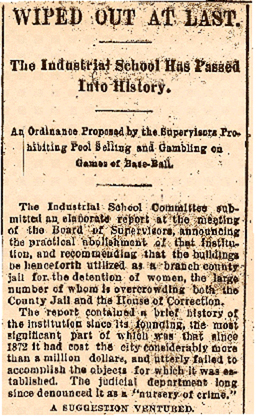
In 1892, the "House of Correction" name was abandoned and the building officially became the Ingleside County Jail.
"Living in his world of Brussels carpets and Axminster rugs and viewing his manly figure in the looking-glass of his $90 etagere one would image that Mr. Dennison should be happy. But he is not. . . . The hall and stairs are carpeted with tapestry Brussells; four sleeping apartments up-stairs are carpeted with the same aristocratic material; the furniture is in black walnut, and, in order that the superintendent's feet may not be dirtied a tapestry carpet covers his very office floor. Few city officials can boast of such a palatial residence and yet the man grumbles." (Daily Evening Post, 8-26-76)
The reporter went on to describe the cells being approximately 5 feet 6 inches wide, 8 feet high and 6 feet 4 inches long. The reporter also noted that, "A man six feet six will of course have to 'double up' in order to fit" in the bed. At the time of the news media's visit, only 50 cells, intended to house 2 prisoners each, were outfitted for occupancy. The Evening Post reporter noted the cells are much smaller than those in the Broadway Jail or at San Quentin. Each cell has a unique lock, so the guards had to have a different key for each cell.

Sheriff Matthew Nunan (served from 1876-79) closed the North Beach Branch Jail on Stockton Street and moved all the prisoners to the House of Correction and the future Ingleside Jail.
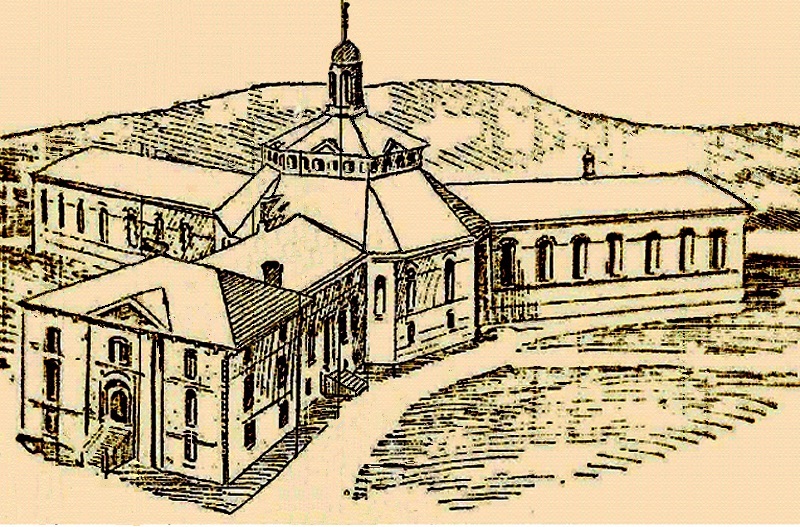
A third wing was added to the House of Correction Building in 1893, increasing its capacity to 600 inmates. (Drawing from The Morning Call, 12-14-1893).
February 20, 1877 -- Sheriff Matthew Nunan was designated as the administrator of the House of Correction by the San Francisco Board of Supervisors. Sheriff Nunan immediately moved 200 county jail prisoners from the "Branch Jail" (at the old City and County Hospital in North Beach), and from the Broadway Jail, into the House of Correction building. Sheriff Nunan removed all county jail prisoners from from the old hospital, fired Superintendent Dennison and replaced him with Superintendent Robert Dore. A local judge issued an order allowing the Sheriff to place county jail prisoners in the House of Correction because the jails were overcrowded, and a "sickness prevailed in the County Jail and Branch Prison that an epidemic was feared." (SFMR 1876-77, p. 171)
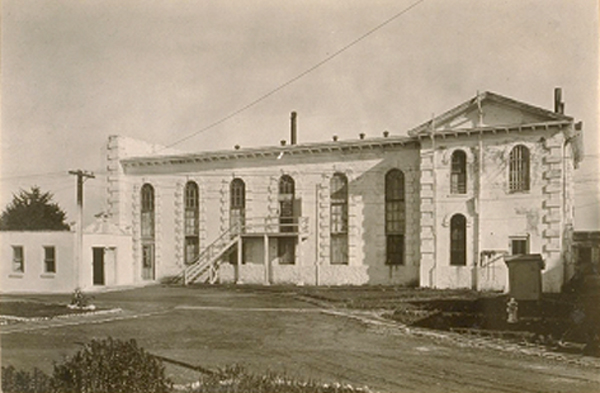
Ingleside Women's Jail, 1925. The building had been restored back to the original Industrial School construction after being severely damaged by the 1906 earthquake (photo, Jesse Cook Album, Bancroft Library, UC Berkeley).
According to House of Correction Superintendent Robert Dore's report to the Board of Supervisors (SF Municipal Reports, 1877-1878) on July 1, 1877) there were 30 House of Correction prisoners and 175 county jail prisoners housed at the facility. Over the course of FY 1877-78, Superintendent Dore received 61 House of Correction prisoners and 169 county jail prisoners.
On June 30, 1878, was a total of 127 prisoners-- still far below the building's capacity. In his report, the Superintendent asked that the cells be lined with iron, over the existing wood, for fire safety and escape prevention. Dore also asked for new and different locks, since "We have a wooden key made by a prisoner, and made in less than thirty minutes, that will unlock the cell as well as an iron key, and made of soft wood at that."
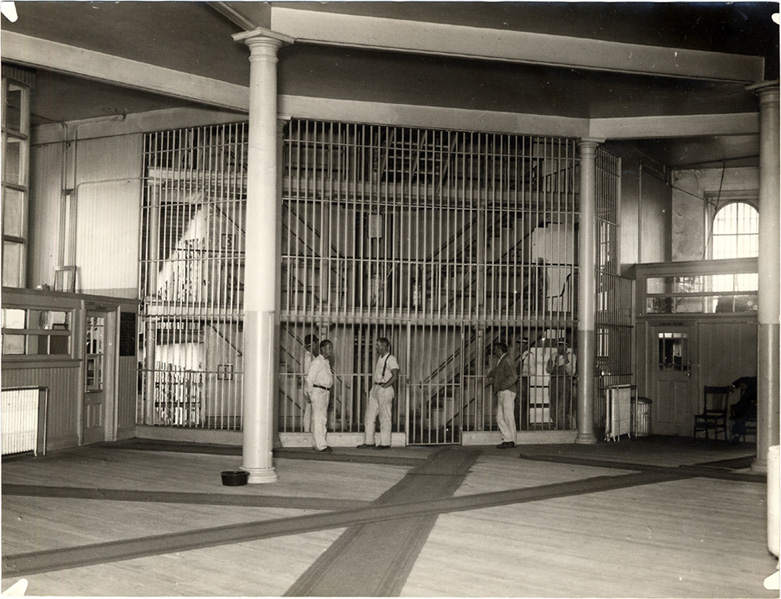
Ingleside Jail - main rotunda. Aspects of the jail's interior design were incorporated into the planning of the replacement jail later built in northern San Mateo County. (News Call Bulletin; photo courtesy of the San Francisco Public Library, History Room)
1890-1891 -- The State opened two Reform Schools, one in Whittier, CA and one at Ione, CA. The next year, the remaining inmates housed at the SF Industrial School were sent to the State Reform Schools. In 1892, The Industrial School for boys was closed and the building was reopened as a women's jail facility run by the Sheriff (Morning Call, 11-24-91)
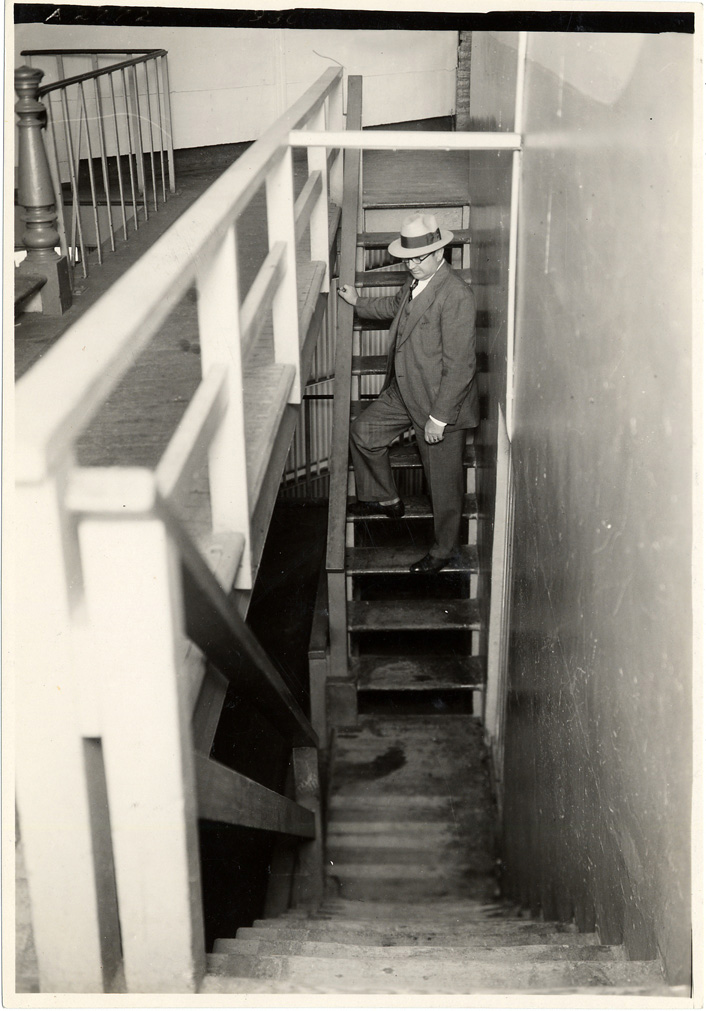
Sheriff William Fitzgerald standing on wooden stairs inside the Ingleside Jail. (News Call Bulletin; photo courtesy of the San Francisco Public Library, History Room)
The Jail also made the news with the usual negative headlines familiar to all correctional facilities: prisoner escapes and jailhouse drug smuggling.
April 18, 1906 -- At 5:12 AM on Wednesday April 18th the San Andreas fault ruptured causing a 7.9 magnitude earthquake that ravished the northern California coast, San Francisco and much of Central California. Over 3,000 people were killed and in San Francisco over 500 city blocks were destroyed.
At the Ingleside Jail, the women's facility (the former Industrial School building) was badly damaged and it appeared that the structure would collapse at any time. One of the main housing wings was destroyed and would be eventually removed. The main jail building (the men’s facility) came through the earthquake without any major structural damage.
County Jail inmates from the Broadway Jail and the damaged Hall of Justice were temporarily housed in the Alameda County Jail in Oakland before finally being transferred and re-housed at the already crowded Ingleside Jail.
1930 -- On April 21, 1930, a major fire at the wood-constructed Ohio State Penitentiary in Columbus killed 322 inmates and seriously injured 150. The tragedy created outrage across the country with demands that public facilities must be made fire safe.
San Francisco's House of Correction was also a wooden-constructed facility (now called the Branch County Jail or the Ingleside Jail) and critics declared it another potential death trap which had long outlived its usefulness. The Ohio State Penitentiary incident was a major turning point in the local public and political perception of the need to build a replacement jail for the Ingleside facility.
Additionally by the mid-1920s, the City's residential expansion had completely surrounded the old House of Refuge property; neighborhoods were being constructed around the county jail that once was criticized for being "too far from the city".
A bond measure for a new replacement county jail, to be build in San Mateo County on watershed land owned by San Francisco, was passed overwhelmingly by the San Francisco Board of Supervisors.
{image
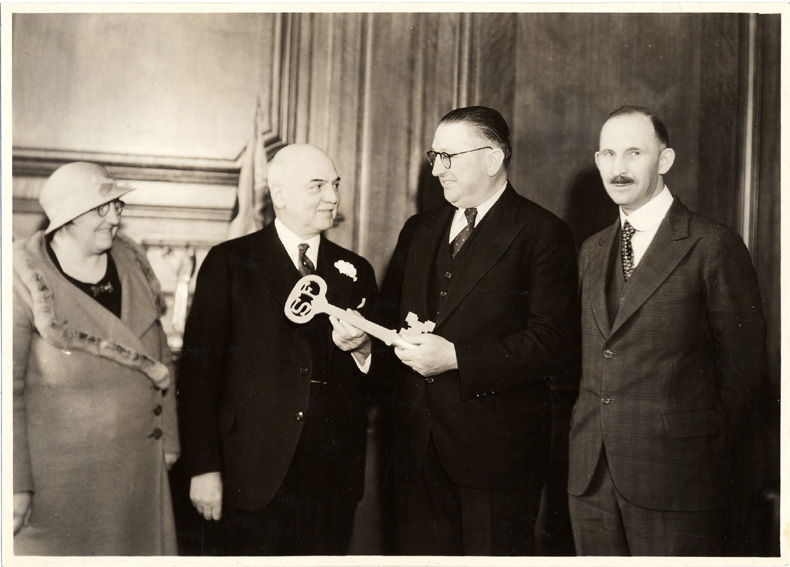
San Francisco Sheriff William Fitzgerald presents ceremonial Ingleside jail key to San Francisco Mayor Angelo Rossi and members of the City 's Recreation Commission on July 9, 1934. (San Francisco Public Library, History Room)
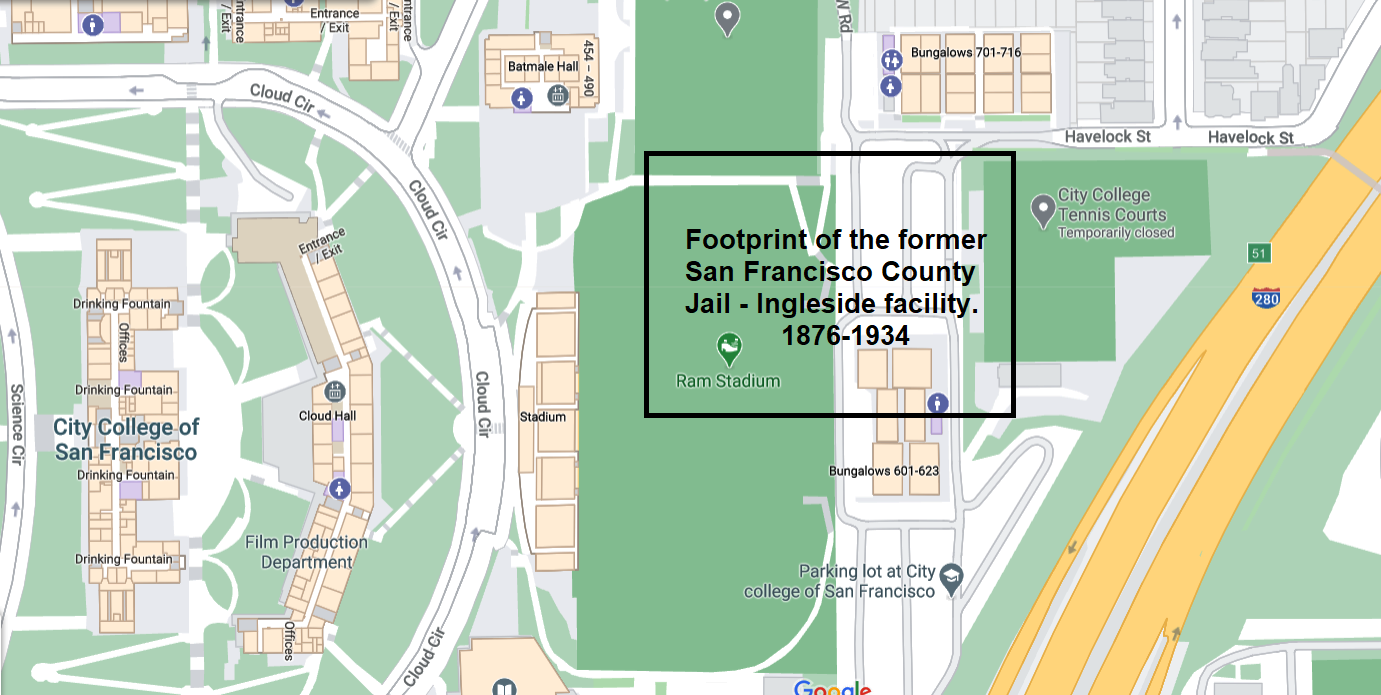
The footprint of the Ingleside Jail on the grounds of City College today.
The original location of the old Jail was just below where Havelock Street ends, extending directly west above the west hashtag line of City College's Ram Stadium; the southern perimeter of the Jail was at the 50 yard line of Ram Stadium; the Jail's western perimeter was (again) along the west hashtags of Ram Stadium; and the eastern perimeter of the old Jail ran between the first and second set of tennis courts just east of the Stadium's north parking lot.
1934 -- Initially, the San Francisco Board of Supervisors had considered constructing the new replacement county jail at Candlestick Point. But after much political wrangling, it was decided the jail would instead be built in San Bruno, 16 miles south of downtown San Francisco on the site of the old Sneath Ranch.
The construction cost was estimated at $850,000. The area around the new jail site was an extremely secluded area of northern San Mateo County, with only the rough, two-lane Skyline Boulevard providing access.
The new County Jail No. 2 San Bruno was dedicated on July 1, 1934, but it was more than two months before the Ingleside prisoners were transferred to the new San Bruno jail. A local newspaper reported, “certain materials needed in the completion” were still on a ship in the Bay". As luck would have it, the day of the new jail’s dedication was also the first day of the infamous 1934 General Strike and no ships were unloaded at the Embarcadero piers for over a month during which one of the most violent labor strikes in the history of the country was underway.
September 13, 1934 -- Busloads of San Francisco County Jail Ingleside prisoners were transported, under tight security by San Francisco Sheriff's deputies with an additional escort by State Police vehicles, to the new County Jail No. 2 in San Bruno.
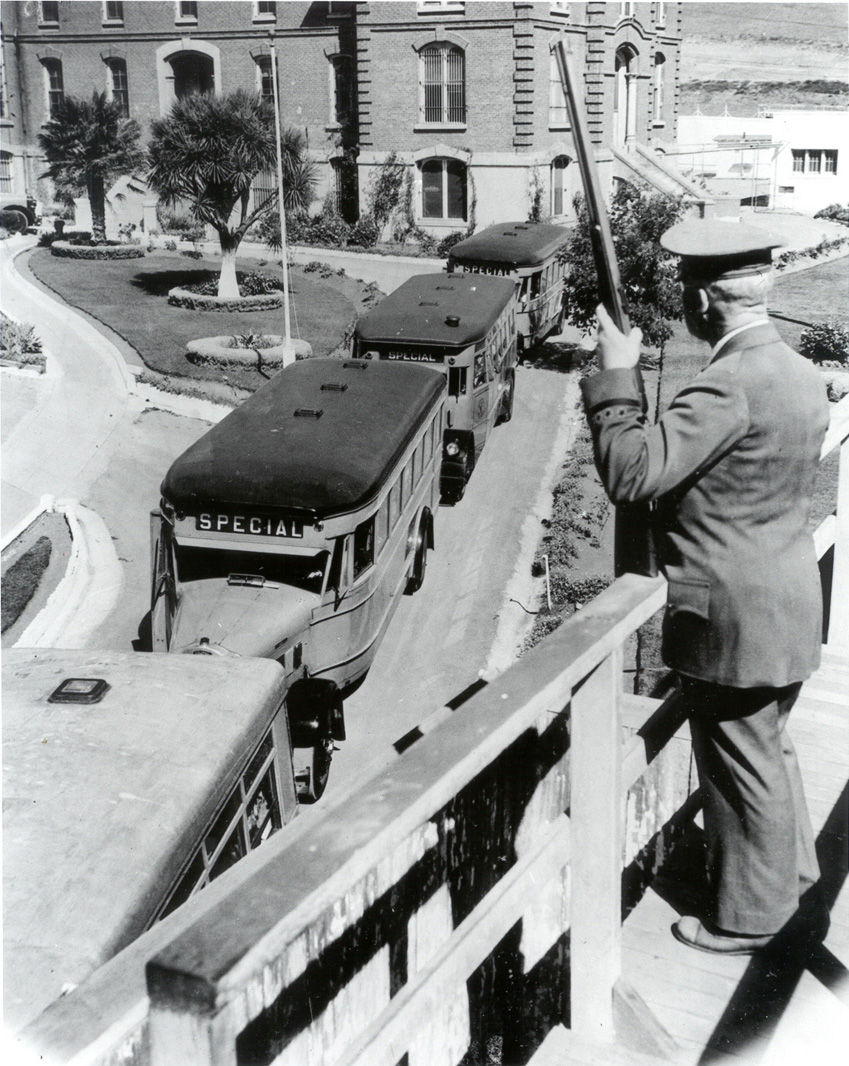
San Francisco Sheriff's Deputy F. A. Bell watches from a gun tower as Ingleside Jail prisoners are transported to the new county jail facility in San Bruno. (News Call Bulletin; photo courtesy of the San Francisco Public Library, History Room)
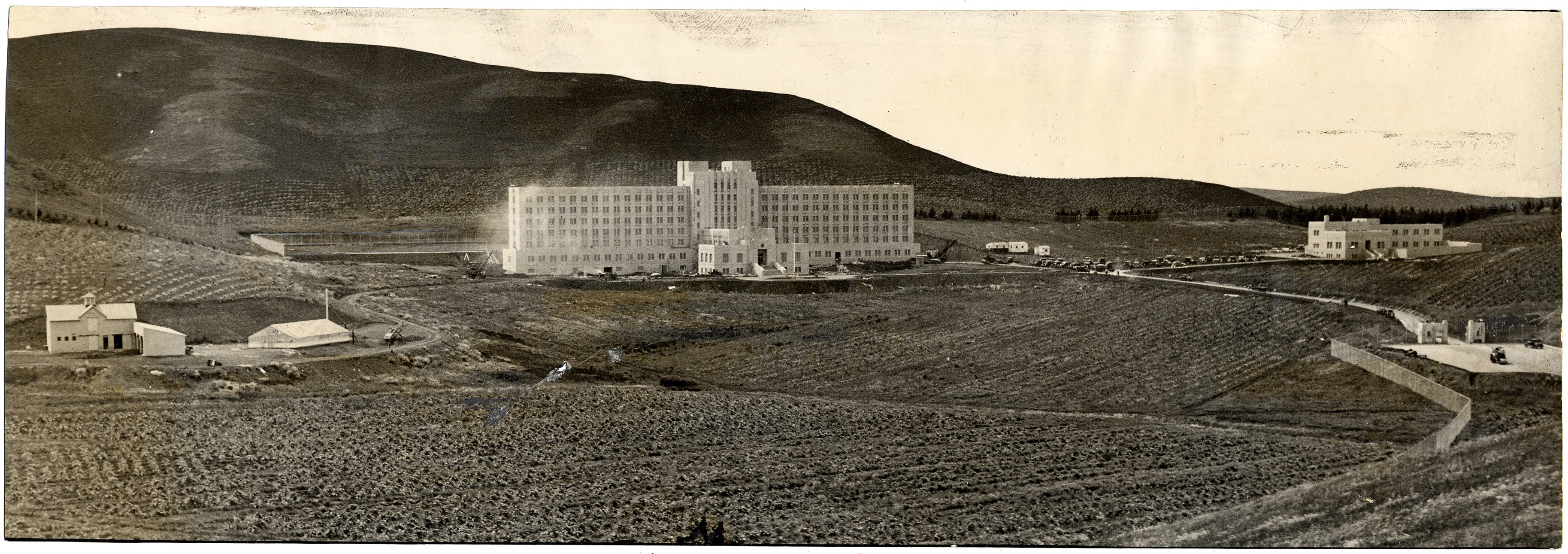
San Francisco County Jail #2 San Bruno, two months prior to completion-- May 21, 1934. Excavators can be seen at either end of the new building raising smoke and dust. Construction workers parked their cars in a lot between the main jail and the women's jail, and behind them are two temporary construction structures and a trailor. A soil compacting roller is working on the area in front of the jail's main entry gate.
The land was previously part of the Sneath Ranch’s “Jersey Dairy #2” location, and acres of carefully tilled land in front of, around and behind the new facility are clearly visible. (News Call Bulletin; photo courtesy of the San Francisco Public Library, History Room)
